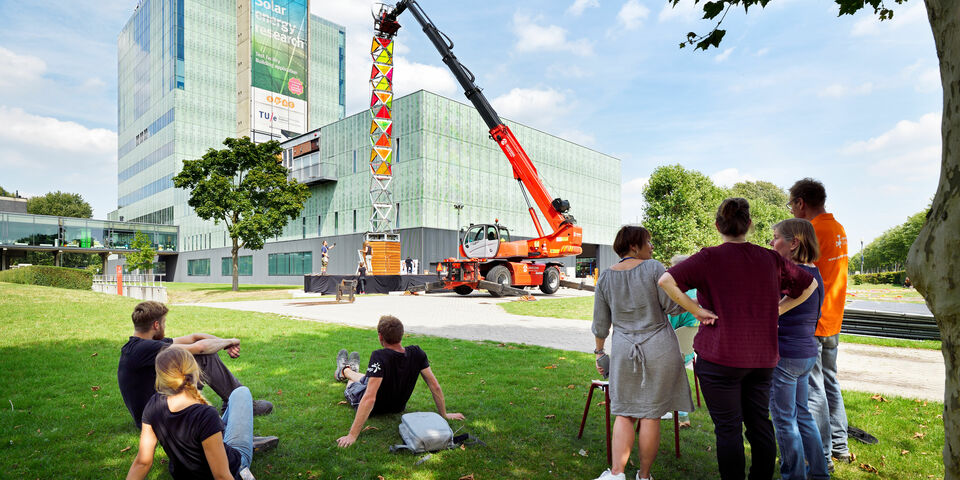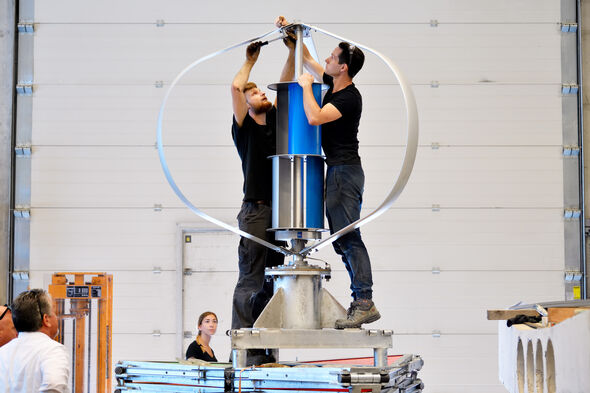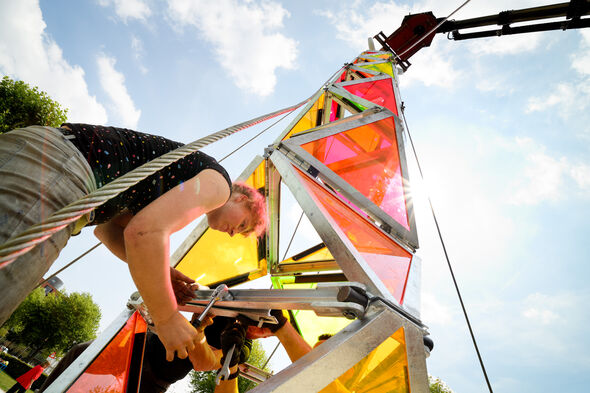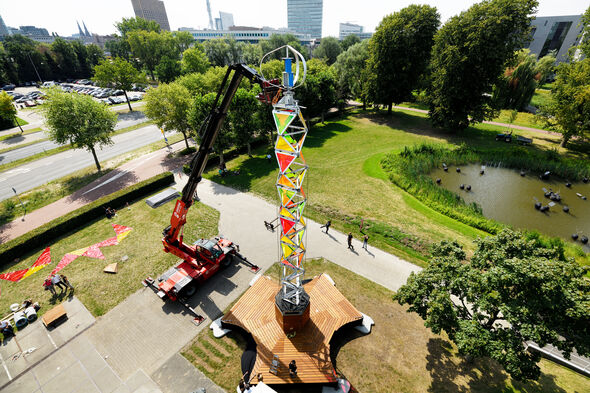Fold-out energy tower is ready for practical use
Almost all festivals in Europe use polluting diesel generators as their power supply. As a sustainable alternative, TU/e researchers and ten companies have developed a 21-meter high fold-out tower with solar collectors and a wind turbine. This week, the ‘GEM-tower’ is fully erected on the TU/e campus for the first time, ahead of the first practical test that will take place next week during Pukkelpop.
The polluting nature of festivals had been a thorn in the side of associate professor of Innovative Structural Design Faas Moonen for years. With a 2.3 million euro subsidy from Interreg Europe, he started working on a sustainable alternative in 2017, appointing a postdoc and three PDEng researchers to help him. Ten companies, including the festival organizers of Pukkelpop and Eurosonic Noorderslag, are currently working on his dream and have given it their all in order to meet the strict safety requirements.
The resulting festival tower is now ready for the first extensive tests. “Eventually, a whole group of towers will have to travel around the European festivals and provide them with 100% sustainable energy,” says Moonen. “I also hope that their striking appearance will make festival goers more aware of sustainability.”
Although entirely sustainable solutions have existed for some time, combining them was a major challenge for the research team. “We had to constantly find a balance between designing a beautiful eye-catcher, guaranteeing safety and our desire to be able to generate as much energy as possible. That was quite a puzzle,” explains Moonen.
Sustainability is not just about generating energy: the tower itself is made of sustainable materials and thought has been given to the sustainable transport of this colossus. Although the precise yield of the tower has yet to be proven through tests, it should be able to generate electricity for no less than 261 days per year. In addition, the base of the tower consists of a three-meter high battery pack that can store 90 kWh of electricity. Energy security can therefore be guaranteed.
Home-grown solar collectors
Most of the energy is generated by a vertical wind turbine weighing 700 kilograms and standing at a height of 18 meters. This height was chosen because the wind blows the hardest above 18 meters. If there’s no wind, solar cells ensure stable power generation. As many as 144 small, flexible thin-foil solar cells adorn the tower. In addition, the research team is supplying 72 large, flexible solar cells that festival organizers can put on the roofs of their food stalls, lavatory units or tents and connect to the tower’s battery pack.
The eye-catchers are the 40 colored solar collectors. These so-called LSC (Luminescent Solar Concentrator) panels were developed at TU/e in the research group of Prof. Michael Debije in the Department of Chemical Engineering and Chemistry. The panels catch incoming rays of light in their plates and transfer them to the edges. In the frames of the panels are solar cells that convert these concentrated light beams into electricity. Moonen: “Because the LSC panels do not need direct sunlight, they are more widely applicable than solar cells. In both the shade and in the sun, they provide energy. Even on a completely cloudy day, they continue to produce electricity.”
Unfolding the tower with a crane
In order to also make transportation more sustainable, the tower has been designed to be foldable. As a result, it takes less than a day to assemble. The 3,500-kilogram steel part of the tower is folded up to be about one-meter thick and can be folded out to a height of 14 meters. The whole thing is attached with 300 joints and 542 bolts. To unfold the current model, a crane is still required, but the next design will need to unfold automatically at the push of a button.
The coming year will be devoted to testing this tower. In 2020, this model will be fully operational and will travel along the festivals. But the research team is certainly not done after just one tower. “We will then start building a new tower which will generate even more power and can also be folded out automatically,” says Moonen enthusiastically. “In addition to the towers, we also want to keep our eyes open to other forms of sustainable energy generation. My dream is to eventually provide all kinds of large-scale events - in both summer and winter - with sustainable electricity through a network of batteries, towers, solar cells and other sustainable innovations.”





Discussion